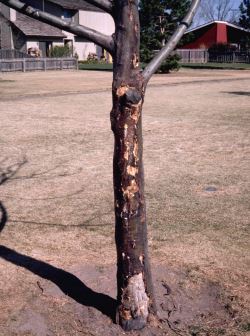Sun Scald or Winter Injury

Over the last few weeks, there have been several questions about trees losing their bark along one side of the tree. If this issue shows up on the south or west side of the tree, it is often caused by sun scalds, also known as winter injuries. This issue poses a significant threat to many thin-barked trees when they are young, but usually, you might not see the damage caused until years later. This issue is common on maple, linden, honeylocust, cottonwood, birch, oak, peach, willow, and ash.
Sunscald refers to the process in which the living cells in the outer bark are damaged by the fluctuation in day-to-night temperatures during the winter. During the day, the sun heats the phloem and causes the sap to run on that side of the tree; when the sun goes down and the temperature drops, the sap freezes, causing the phloem cells to burst from the expanding sap. Damage can result in discolored bark, bark cracking, sunken areas from lack of growth, or the bark falling off to reveal the dead tissue within the damaged area. This damage can cause significant stress to the tree, especially during heat or drought, and can be a location for insects or diseases to enter the tree. Never cover the area with tar or any sealing substance, as that can worsen things, but you can wrap the trunk with light-colored tree wrap. In many instances, the damage will eventually heal. However, it’s best to prevent sun scald when possible. In the fall, wrap the trunk with a light-colored tree wrap to help protect the trunk and lower branches from the temperature extremes. You can also use a plastic tree guard around the trunk to help deflect the sunlight. Wrap the tree for the first two to three winters to keep the trunk safe until the bark thickens. It’s also been found that drought-stressed trees tend to be more susceptible to sunscald, so try to water the trees through the winter to help reduce the chances of having issues. We are getting close to wrapping the young trees for the winter, so anytime in the next few weeks would be the ideal time to protect them.

Have questions? Contact our office where our Horticulture Extension Agent will assist you with questions.
Phone: (316) 321-9660
Email: callae@ksu.edu